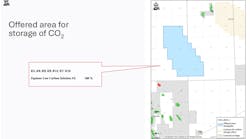Underbalanced drilling (UBD) is a specific drilling technique whereby the pressure of the drilling fluid is intentionally maintained at a value inferior to the formation pressure. Depleted reservoirs or heavy loss wells are good candidates for this technique. Many advantages can be provided by this non-conventional drilling approach:
- Formation damage and fluid losses through formation (highly fractured or not) are minimized
- Higher ROP is attainable, bit life is increased
- Differential sticking is reduced
- Better hole cleaning results, with limited flow rate and equivalent circulating density (ECD).
Since pressure is lower in the fluid than in the formation, production can occur while drilling the reservoir zone. In this case, it is necessary to provide special surface equipment to separate oil from drilling fluid.
Onshore, the number of applications using underbalanced drilling is increasing, particularly in Canada and the USA, where 25% of the wells are drilled underbalanced. Offshore applications are very recent and almost exclusively with coiled tubing. A first offshore application of reservoir UBD with jointed pipes was performed by Shell UK on the Leman Field in the southern North Sea mid-1997.
Elsewhere, UBD has been investigated by BP to reduce ECD in very long 12 1/4-in. sections. Petrobras has deployed the technique for deepwater applications to reduce formation damage. Technical limitations relate to wellbore instability or water inflow, but a really major obstacle to use of UBD is the lack of knowledge on the specific underbalanced drilling fluids properties.
Low density fluids
One way to achieve underbalanced conditions is to use low density fluids as gasified liquid, mist, or foam. Foam is very beneficial due to its low density, coupled with its good cuttings carrying capacity.
Foam must be very stable within the well and must be easily breakable at the surface for environmental purposes, especially for offshore installations, since used foam cannot be discharged into the sea. Accurate characterization of foam properties must therefore be undertaken.
Foam cannot be considered a classical fluid and must be seen as a dispersion of gas bubbles in a continuous liquid matrix. The presence of a surfactant (foaming agent) in the liquid phase stabilizes the film which forms bubbles and allows the foam to persist for a given period. Due to its own nature, a foam is a thermodynamically unstable system, contrary to either water or oil based muds which remain stable over considerable drilling time scales.
To further application of UBD, knowledge of foam behavior and rheology must demonstrate that foam's natural tendency to instability can
be addressed and eventually controlled. Cooperative work in this regard between TotalFina and IFP (Institut Francais du Petrole) has been executed though the Artep research group (also comprising Elf and Gaz de France) in order to provide reproducible methodologies and procedures to characterize drilling foam properties. Each drilling foam can be characterized by its "static" properties (relating to the problem of foam instability) and also its "dynamic" properties, related to behavior of flowing foam (rheology, influence of shear rate).
Static properties
The influence of different parameters on stability properties of an aqueous foam already widely used in drilling operations has been extensively tested. Stability of each foam formulation is approached through a normalized drainage test which gives the value of the half-life drainage velocity. Foaming capacity is derived from the volume of foam produced in a normalized way. Using these two normalized parameters, each foam system is well characterized.
Foam is created by mixing gas into a liquid phase called a foaming solution, optimization of this formulation in terms of foam stability is performed by studying the influence of foaming agent concentration, the sensitivity to different sources of contamination (electrolytes, oil) which may be encountered on site, and the influence of pH change.
Enhancement of foam stability is made possible by adding water-soluble polymers to the foaming solution. For example, the addition of Xanther polymer decreases the drainage velocity, which in turn increases foam stability. However, above a certain amount, foaming capacity of the formulation begins to decrease.
A compromise between the two parameters must therefore be reached. The role of the liquid foaming solution low shear rheology has been determined, and the influence of yield stress, shear-thinning, and visco-elasticity of the liquid phase on the resultant foam properties has been studied. Correlations between foam stability properties and liquid phase low shear rheology have been highlighted. With these procedures, foam stability properties for each site configuration can be easily determined.
The influence of pressure up to 100 bar and temperature up to 100°C is determined in a sapphire cell equipped with a visualization window.
Generation of foam at different pressure values and cycles of compression and decompression have been performed in order to simulate drilling conditions. Results have shown that foam is destabilized at high temperatures. However, creating foam at a weak pressure is sufficient to enhance stability greatly.
Simultaneous with these experiments, foam structure has been examined and size distribution computed. A correlation between the foam stability and the size of the bubbles has been well established. Studies also have shown that foams created under a pressure of 10 bar are four times more stable than foams produced under atmospheric pressure, while at the same time, the bubbles' mean size is ten times less. Higher pressure tests did not reveal any further evolution. This study enables us to approach downhole conditions and to determine foam behavior under actual pressures and temperatures.
Flowing properties
In order to predict accurately downhole pressures while drilling, it is necessary to know precisely the rheological behavior of the drilling foam. A foam's apparent viscosity is not only a function of its quality (the ratio between gas volume and total foam volume), but also of its texture (bubble size distribution) and of the presence of polymers in the aqueous matrix.
Despite numerous experimental studies of foam rheology, behavior of foam under shear is not clearly characterized. Inversely to simple fluids, foam rheological measurements depend strong ly on various parameters and experimental results could differ widely when all these parameters are not controlled.
A careful experimental procedure was performed through this study which employed a parallel plates geometry. Attention was paid to foam stability, texture, and evolution properties in order to secure correct and reproducible measurements. In particular, wall slip phenomena and strain localization were investigated and controlled. Shear flow properties were thus determined for different foam formulations with a very satisfying repeatability.
Small amplitude oscillatory shearing experiments have demonstrated that foam be haves like an elastic solid for small deformations. An excellent agreement was established between the different measurements.
All these different approaches have proven to be coherent and reproducible and constitute a precise methodology for characterizing foam rheological behavior under ambient conditions. Downhole conditions (HP/HT) flowing properties will be studied in the near future using a recirculating loop.
Different formulations can be compared in terms of flowing or static properties. This could also be extended to placement of foamed cement, something which is being applied more widely as deepwater drilling develops.


